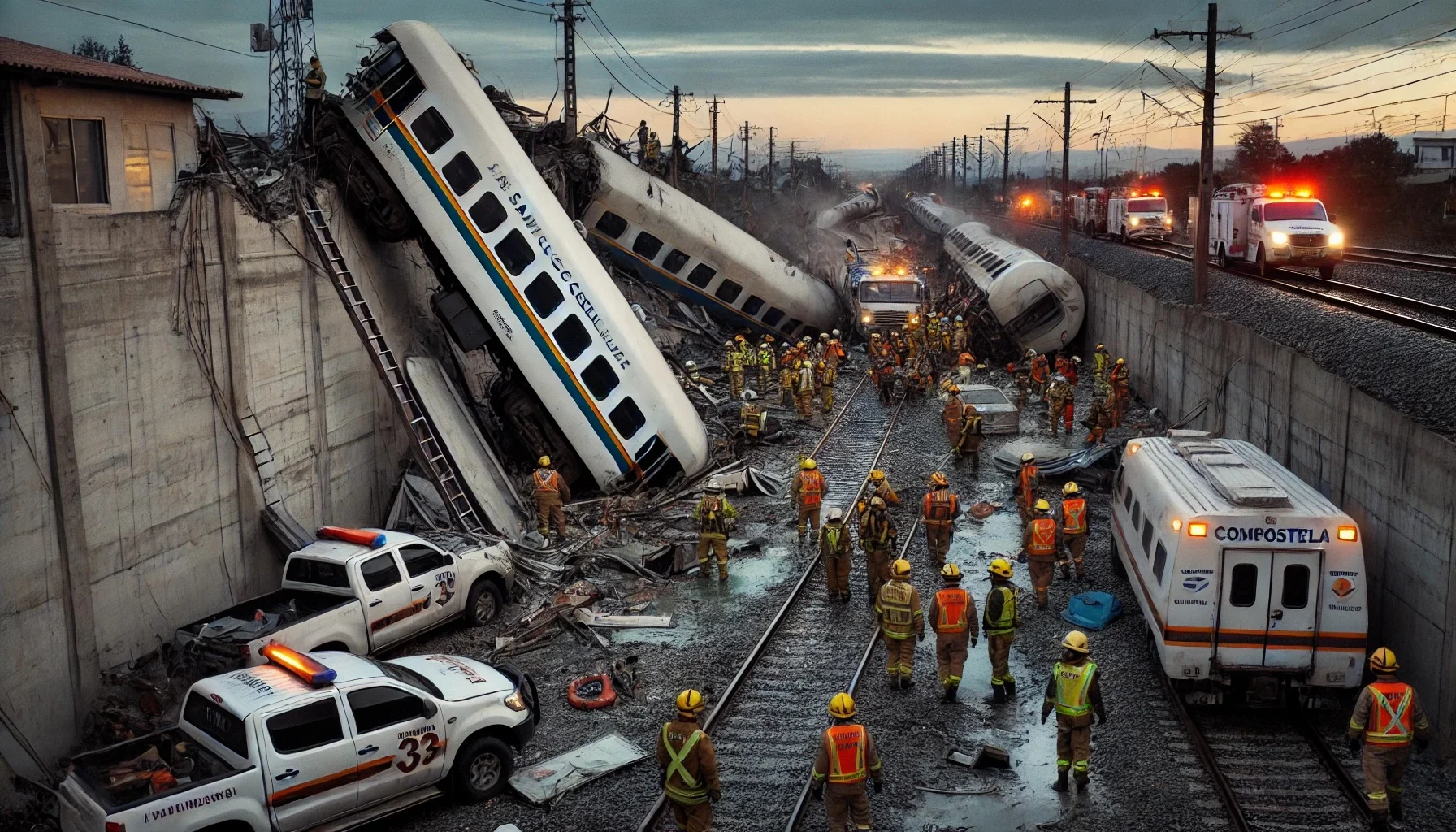
The Santiago de Compostela Train Derailment
by: The Calamity Calendar Team
July 24, 2013
A Journey Turns Tragic
On the evening of July 24, 2013, the Alvia 730, a high-speed train operated by Renfe, embarked on its routine journey from Madrid to Ferrol. With 218 passengers and four crew members aboard, the train sped along the Spanish countryside, utilizing the advanced technology and stringent safety measures of Spain’s high-speed rail network.
However, the picturesque landscape masked a lurking danger. As the train approached the A Grandeira curve near Santiago de Compostela, it was traveling at a perilous speed of 190 km/h (118 mph), drastically exceeding the curve’s speed limit of 80 km/h (50 mph). At 8:41 PM, disaster struck. The train, unable to negotiate the sharp turn, derailed, causing a catastrophic crash.
Immediate Aftermath
The scene that unfolded was one of utter devastation. The derailed carriages collided with a concrete wall, overturning and crumpling under the impact. The immediate aftermath saw local residents rushing to the site, their quiet evening shattered by the horrifying noise and sight of the crash. Emergency services arrived swiftly, but the scale of the disaster necessitated a massive and coordinated rescue operation.
First responders and volunteers worked tirelessly to pull survivors from the wreckage, their efforts hampered by the twisted metal and debris. The community’s rapid and selfless response was a poignant testament to human resilience and compassion in the face of tragedy.
Thanks for subscribing!
A Grim Toll
As dawn broke over Santiago de Compostela, the full extent of the tragedy became clear. Seventy-nine lives were lost, and approximately 140 people were injured, some critically. Families were torn apart, and the tight-knit community was left reeling from the disaster. The derailment marked one of the deadliest train accidents in Spanish history, its impact felt deeply across the nation.
The physical damage was equally significant. The train and railway infrastructure suffered extensive destruction, with repair costs running into millions of dollars. Renfe and Adif, the railway infrastructure manager, faced not only financial repercussions but also a severe blow to their reputations.
Seeking Answers
In the wake of the derailment, an intense investigation was launched to uncover the causes of the disaster. Attention quickly turned to Francisco José Garzón, the train driver. Garzón admitted to being distracted by a phone call at the critical moment and failing to brake in time. His candid confession led to charges of 79 counts of homicide by professional recklessness.
The legal proceedings were fraught with emotion and controversy, sparking debates over safety protocols and the responsibilities of train operators. The tragedy underscored the delicate balance between maintaining high-speed travel and ensuring passenger safety.
A Catalyst for Change
The Santiago de Compostela derailment became a catalyst for significant changes in Spain’s railway safety measures. Renfe and Adif implemented stricter protocols, including the installation of automatic braking systems on high-speed sections and enhanced monitoring of speed limits. These measures aimed to prevent human error and bolster the safety of Spain’s rail network.
Technological advancements in train control systems were also accelerated, integrating more comprehensive automated systems designed to intervene when speed limits are exceeded. These improvements reflected a commitment to learning from the tragedy and preventing such disasters in the future.
Legacy and Remembrance
A decade later, the Santiago de Compostela train derailment remains a somber chapter in Spain’s history. Annual commemorations honor the victims, ensuring that their memories are not forgotten. The accident serves as a poignant reminder of the critical importance of rigorous safety protocols in public transportation.
Ongoing studies and debates continue to draw lessons from the event, striving to balance the pursuit of speed with the paramount need for safety. The legacy of the Santiago de Compostela derailment is a testament to the resilience of the human spirit and a continuous call to action for the safety of all who travel by train.
Stay in the Loop!
Become a Calamity Insider and get exclusive Calamity Calendar updates delivered straight to your inbox.
Thanks! You're now subscribed.